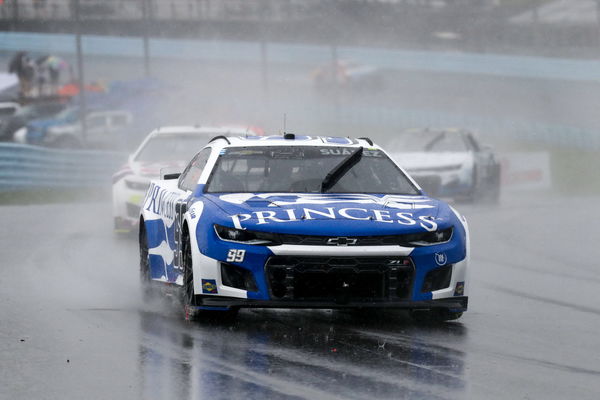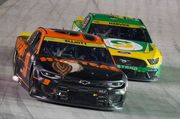
via Reuters
NASCAR Cup Series driver Daniel Suarez (99) runs in the rain in his Chevrolet | Credit: Reuters

via Reuters
NASCAR Cup Series driver Daniel Suarez (99) runs in the rain in his Chevrolet | Credit: Reuters
Isn’t it heartbreaking when you are waiting for your favorite NASCAR driver to make it to the tracks and yet they end up staying indoors – all because of rain? During the 2024 NASCAR Cup Series, 6 of the 36 races were spoiled only because of rain. The Daytona 500 had to be rescheduled to the next day owing to detrimental weather conditions. While switching to rain tires can be a resolution for some cars, it is never a long-term solution.
In such cases, a common question to ask is why not opt in for covering the tracks with a dome? Recently, the Joe Gibbs Racing team shared a detailed video about how this endeavor is possible on paper, but in practice, it is way trickier than you would imagine, especially financially.
ADVERTISEMENT
Article continues below this ad
Why NASCAR cannot cover up the tracks despite their wish
Covering the race tracks with a dome might seem to be a probable choice to ensure that there is no impact of rain on the races. However, it does bring on some logistical challenges. The first problem with this plan is that the NASCAR tracks are usually a combination of various forms. There are 42 tracks in total with varying changes in length. For example, while the Daytona International Speedway extends for about 2.5 miles, the Bristol Motor Speedway is for only 0.533 miles.
The second reason behind the same is issues with technicalities. A closed space leads to more noise and emissions because it restricts their natural dissipation. Sound waves, instead of dispersing, reflect off walls and ceilings, amplifying noise through echoes and reverberations. This will lead to a disappointing experience for the audience who are inside the stadium.
However, the biggest problem remains that of finances. Citing the same, the Joe Gibbs Racing Team shared a bill about how much it would cost to cover up tracks. It said, “The main issue for a NASCAR track would be the cost. A dome to one mile track was proposed in Connecticut with a cost of 400 million in 2004.” Just thinking about that number accounting for today’s inflation is enough to make NASCAR reconsider a dome.
“A roof at Bristol Motor Speedway at half a mile is actually feasible. It would come at the cost of $80 million. The key would be not fully enclosing the track giving emissions and sound a place to go. But this idea would be way too expensive at some of the larger tracks such as Talladega at over two and a half miles”. So it is clear that NASCAR would not be able to dome every track on the circuit, but there is still hope for the future. If the Bristol dome does become a reality, it could serve as a blueprint for future domes across the country with tweaks where necessary. However, all this is an optimistic speculation for now.
View this post on Instagram
While the idea of domed NASCAR tracks may seem appealing to prevent rain delays, the logistical and financial challenges make it nearly impossible to execute. For now, NASCAR must continue exploring alternative solutions to balance costs and ensure fans enjoy uninterrupted races. Their current method is not too shabby at all, despite its drawbacks.
Trending
ADVERTISEMENT
Article continues below this ad
Air Titan – NASCAR’s proactive endeavor to combat wet tracks
While NASCAR might not be able to afford $400 million in one go, it has constantly brought forth new endeavors that are a testament to its willingness to improve. One such example is the Air Titan, which is a track drying mechanism. However, the biggest development came when the Air Titan 2.0 was launched in 2014.
With a single self-contained unit, this one is placed right at the top of the Toyota Tundra and it can disperse air at a speed of 585 mph. This ensures that the track can be dried quickly, depending on how long the stretch is. Such is the marvel of this mechanism that it also has the capability of raising the temperature by 70 degrees over ambient. The combination of water removal along with accelerated evaporation tends to work like magic.
In comparison to the original Air Titan, the upgraded version consumes 78% less fuel per hour, emits 80% less Co2 per hour, and reduces drying time by 25-50% depending on atmospheric conditions. These advancements have certainly benefitted the sport and NASCAR. Speaking on the success of this in 2014, then NASCAR Chairman and CEO Brian France said, “Developed by our engineers at the NASCAR R&D Center, Air Titan 2.0 will help us more quickly return to racing, which serves our most important mission — the enjoyment of our fans. It’s faster, more agile and eco-friendly. The new Air Titan creates the ultimate win-win-win for our sport, our fans and our environment.”
ADVERTISEMENT
Article continues below this ad
However, the Air Titan 2.0 is an answer to post-rain strategies. Currently, NASCAR does not have any mechanism to continue with a race if the weather suddenly turns inclement. While the Air Titan 2.0 showcases NASCAR’s innovative efforts to tackle rain-affected tracks, the need for a solution to manage races during a sudden downpour remains an ongoing challenge.
ADVERTISEMENT
ADVERTISEMENT
ADVERTISEMENT
ADVERTISEMENT






